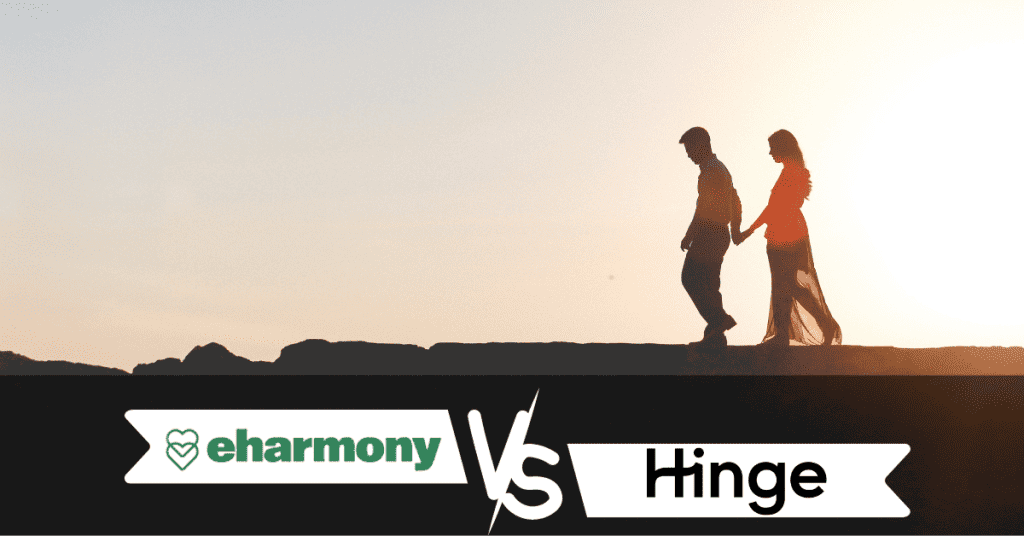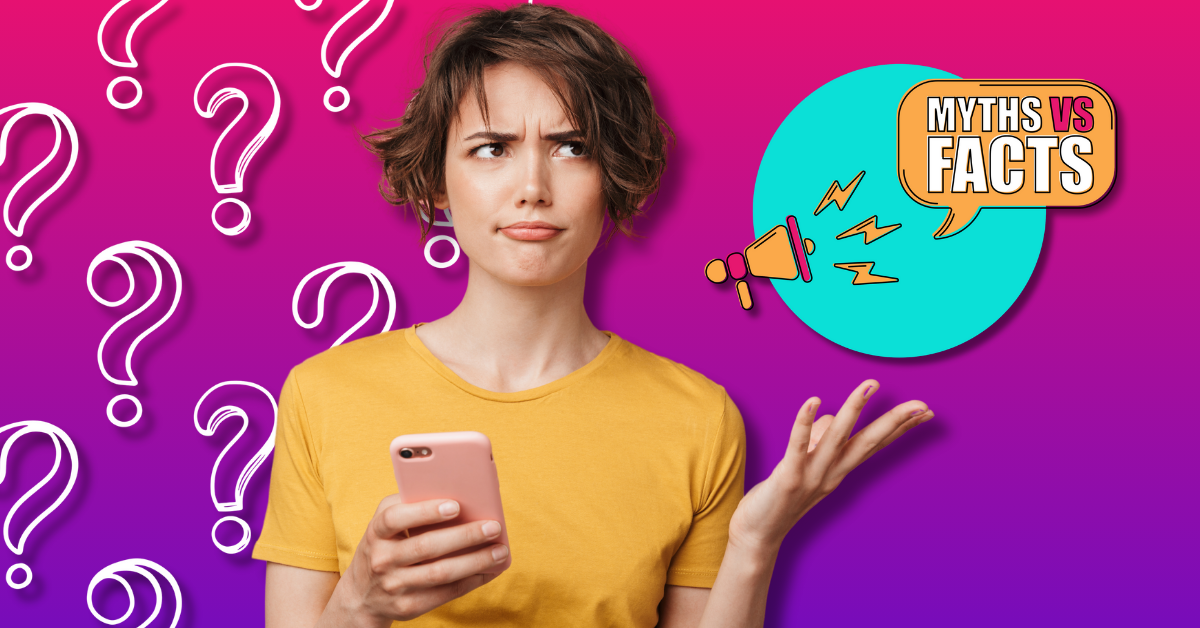eharmony vs Hinge, you’ve heard of them, correct? If you answered “no,” then you are either a toddler or a senior citizen. And even then, some of that demo has probably heard of both dating apps. The platforms exist to guide people toward love, albeit in different ways. eharmony uses a super detailed questionnaire to understand its users and then uses that info to help them find matches that could likely lead to long-term relationships. On the other hand, Hinge keeps things light and fun, letting users interact more freely with each other’s profiles and making it easy to start conversations based on mutual interests and likes.
While they both serve people looking for serious romantic relationships, eharmony uses a scientific and detailed approach, using a person’s answers to specific questions to help find truly compatible matches. Hinge is more about creating a fun and engaging space where users can easily interact and connect with each other over shared interests or fun profile prompts and icebreakers.
Comparing the two, we (and the rest of the dating world) see eharmony as the more structured platform that carefully selects matches based on compatibility, while Hinge offers a more relaxed and interactive environment, appealing to those who want a more chill atmosphere and casual dating choices. Both have their own way of helping users find love, and the best fit will obviously depend on your personal dating style and preferences!
Side to Side Comparison
When stepping into the big wide world of online dating, picking the right app can be a big decision—after all, you could find your soulmate! In our comprehensive comparison of eharmony and Hinge, we’re going to examine the key things that will aid you in deciding which one is right for you. We’ll explore each app’s different features, the kinds of daters you’ll find on each platform, and what (if any) free trials or starting offers they have for new members.
Features can undoubtedly shape your online dating experience—eharmony is known for using detailed questions to help find compatible matches, while Hinge allows for more easy-going interactions through comments and likes on profiles. Both have their own way of helping you connect with potential partners, and we’ll talk about these differences.
We’ll also take a close look at who’s using these apps. Different age groups and types of daters might prefer one app over the other. And, of course, we’ll let you know the premium membership pricing so you’ll know how much they are before you commit to a subscription. By comparing these aspects, we hope to give you a big, crystal clear picture of what you’d find if you sign up for eharmony or Hinge!

eharmony
- Target Demographic: Individuals looking for long-term relationships
- Approach to Matching: Uses a comprehensive personality test to find compatible matches based on psychological principles
- Main Features: Detailed personality assessment, compatibility matching system, guided communication options for matches, and video dating
- Subscription Options: Various plans are available, including free, basic, and premium memberships with different features and pricing
- User Experience: Generally user-friendly but with a focus on detailed profiles and serious dating, somewhat formal
- Popular In: United States, Canada, United Kingdom, and Australia
- Security Features: ID verification, secure calls feature, and incognito mode
- Success: Known for creating long-term relationships and marriages
Hinge
- Target Demographic: Young adults looking for meaningful, lasting relationships
- Approach to Matching: Encourages users to like and comment on specific aspects of potential matches’ profiles to initiate conversation
- Main Features: Profile creation with photos and prompt answers, ability to like and comment on specific parts of profiles, an algorithm that learns your type over time, “We Met” feature to provide feedback on dates
- Subscription Options: A free version is available, with a premium subscription (Hinge Preferred) offering additional features like unlimited likes and advanced preferences
- User Experience: Friendly and interactive with a focus on engaging and natural conversations
- Popular In: Predominantly popular in urban areas in the United States, United Kingdom, Canada, and Australia
- Security Features: Phone number verification, advanced preferences and filters
- Success: Recognized for facilitating dates and relationships, with a focus on being “designed to be deleted.”
User Demographics
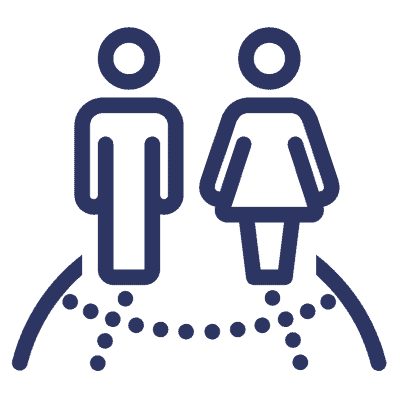
eharmony and Hinge cater to folks who are looking for love, but they each have their own vibe and attract different kinds of people. eharmony, with its detailed approach to matching, tends to pull in people who are really focused on finding long-term relationships, often appealing to a slightly older demographic. Hinge, on the other hand, with its easy-going and interactive platform, tends to be a hit among younger adults who are looking to connect in a fun yet meaningful way. Here’s a bit more about who you might find on each app.
- eharmony:
- Age Range: Broad, but popular among 30-50 year olds
- Relationship Goals: Primarily individuals seeking long-term relationships and marriage
- Global Reach: Substantial user base in the United States, Canada, United Kingdom, and Australia
- User Base Characteristics: Diverse, with a variety of professions, backgrounds, and interests, but generally more serious daters
- Hinge:
- Age Range: Primarily 20-35 year olds
- Relationship Goals: People looking for meaningful, lasting relationships but with a more casual interaction style
- Global Reach: Popular in urban areas across the United States, United Kingdom, Canada, and Australia
- User Base Characteristics: Generally young professionals who are tech-savvy and enjoy a more interactive and dynamic platform
User Interface and Experience

The user interface and overall experience can greatly influence a user’s path on the road to finding a match. eharmony and Hinge, while both renowned for creating lasting connections, present totally different interfaces and user experiences, each catering to their respective demographics and dating goals! eharmony leans heavily on a more disciplined and guided user experience, while Hinge offers an interactive and explorative platform. Below is a brief overview of the characteristic features of each app’s UI and experience.
- eharmony:
- Interface Style: Clean and somewhat formal, designed to present detailed user profiles
- Matching Approach: Provides matches based on a comprehensive personality assessment and compatibility algorithm
- Communication: Guided communication options to help users initiate conversations and connect
- Navigation: User-friendly with straightforward navigation and clearly defined features
- Unique Feature: Detailed compatibility insights based on personality assessment
- Hinge:
- Interface Style: Modern and casual, prioritizing visually appealing profile layouts
- Matching Approach: Encourages users to like and comment on specific elements of a user’s profile to initiate interaction
- Communication: Direct messaging once a ‘like’ on a profile element is reciprocated
- Navigation: Intuitive and easy-to-use with straightforward features and swipe functionality
- Unique Feature: Prompts and photo/comment interactions that foster engaging conversations
Features

Choosing a dating app can come down to the features that make it fun and easy to connect with others. eharmony gives users detailed profiles and guided communication to help find serious matches, while Hinge provides an interactive and casual space to start conversations easily. Let’s take a closer look at what each app offers in the way of fun (and beneficial) perks!
- eharmony:
- Compatibility Quiz: A detailed questionnaire designed to understand your personality and preferences.
- Guided Communication: Offers pre-set messages and questions to help users initiate conversations.
- Video Date: Allows users to have virtual dates within the platform.
- Compatibility Score: This shows your compatibility with your matches based on your quiz answers.
- Send a Smile: A feature to show interest without sending a message.
- Hinge:
- Profile Prompts: Offers various prompts to help users create engaging profiles.
- Like and Comment Feature: Users can like and comment on specific parts of profiles to initiate connection.
- We Met: Allows users to give feedback on their dates, which informs the app’s algorithm.
- Who Liked Me: Allows users to see who has liked their profile.
Pricing

Pricing can be a crucial factor for many when exploring online dating apps like eharmony and Hinge. The cost and what you get for your money can influence where you decide to look for love online. eharmony typically targets users looking for long-term relationships and offers different subscription plans, while Hinge provides a free usage option with additional perks available through its premium membership. Let’s break down the key pricing aspects of each app.
- eharmony:
- Free Version: Limited features but includes the personality test and viewing of profiles.
- Premium Light: The six-month plan ($65.90 per month) includes unlimited messaging and viewing of all photos.
- Premium Plus: 12-month plan ($45.90 per month) with extra features such as detailed personality analysis.
- Premium EXTRA: 24-month plan ($35.90 per month) offering the most savings and all available features.
- Hinge:
- Free Version: Allows for limited likes and all essential features for matching and messaging.
- Preferred Membership: Offers unlimited likes, the option to see everyone who likes you and advanced filtering preferences.
- Pricing Tiers: Available as 1 ($34.99), 3 ($21.66 per month), or 6-month ($16.66 per month) plan.
Background and History: eharmony vs Hinge
eharmony and Hinge are hugely successful dating apps, but they didn’t always exist in the way we know them ATM. eharmony started back in 2000 with the goal of helping people find serious, long-lasting love using a detailed personality quiz to match users. Hinge, launched in 2012, wanted to create a space where young adults could easily start conversations and connect over shared interests, becoming known as the app meant to be deleted once you find your match. Let’s look at some basic details about each.

eharmony
- Founded: 2000
- Founder: Dr. Neil Clark Warren
- Foundational Philosophy: Using psychological principles and comprehensive personality assessments to foster long-term relationships
- Initial Audience: Individuals of all age groups, with a focus on those seeking serious, lasting partnerships
- Key Evolution: Broadened its user base and updated its interface and user experience to be more contemporary while maintaining a focus on serious dating
- Notable Aspect: Recognized for creating numerous marriages and long-term relationships through its tailored matching process
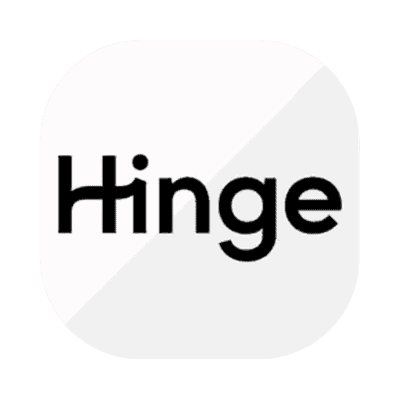
Hinge
- Founded: 2012
- Founder: Justin McLeod
- Core Concept: Encouraging meaningful connections through interactive profiles and focused user engagement
- Primary Demographic: Young adults in urban areas
- Significant Shift: Transitioned from a “swiping” app to a platform prioritizing user interactions and relationship-building
- Distinctive Feature: Stands out for its user-friendly interface that facilitates natural and substantive conversations from the get-go
Free Trial Comparisons: eharmony vs Hinge
Taking a dating app for a spin with a free trial can be a great way to understand how it works and what it offers before committing to a paid plan. Both eharmony and Hinge allow users to explore their platforms to a degree for free, but they approach their free trials and free versions differently. Below, we explore what each platform offers to users who are trying out the service without initially putting money down.

eharmony Free Trial
- Basic Access: Allows users to take the personality test and see matches.
- Limited Functionality: Free users can send winks but cannot initiate conversations.
- Profile Browsing: View profiles but limited access to photos.
- Duration: Not bound by a specific timeframe but continuous with limited features.

Hinge Free Trial
- Profile Creation: Users can create a full profile and view others’ profiles.
- Limited Likes: Provides a certain number of likes per day.
- Messaging: Users can message with matches without a premium subscription.
- Duration: Indefinite use with the above features, no specific trial period.
Success Rates: eharmony vs Hinge
Looking at how “successful” (the definition is different for everyone) people are on dating apps like eharmony and Hinge can tell you a lot about how well they work. eharmony often boasts about its success in helping people find long-term love, while Hinge likes to share how it gets people dates that lead them to delete the app because they found “the one.”

eharmony
- Long-Term: Known for a high rate of long-term relationships and marriages among users.
- Global Reach: Claims to have a significant number of users finding love globally every day.
- Research-Based: Prides itself on research-based methods to optimize matching for long-term relationship success.
- Testimonials: Features numerous success stories and testimonials on its website.

Hinge
- Dates: Positions itself as the app “designed to be deleted,” indicating a focus on successful dates.
- Relationship-Oriented: Claims that it’s the #1 mobile-first dating app mentioned in the New York Times wedding section.
- User Feedback: Actively collects and highlights user feedback about dates and relationships started on the app.
Signing Up: eharmony vs Hinge
The sign-up methods on dating apps like eharmony and Hinge are made to create user profiles that will coordinate with their respective matching algorithms and community feel. While both intend to make this initial step user-friendly, the required details and depth of info can vary—see how below!

eharmony
- Compatibility Quiz: A thorough questionnaire to gather detailed personality and preference insights.
- Profile Creation: Users create a profile, adding photos and additional information.
- Interaction: Limited interaction with matches under the free version.

Hinge
- Profile Setup: Requires users to add photos, answer prompts, and specify preferences.
- Linking Accounts: Option to sign up using Facebook or a mobile number.
- Browsing: Users can immediately browse and interact with other profiles.
- Likes and Comments: Free version users can send a limited number of likes and comments to initiate conversations.
Dedicated Mobile Apps: eharmony vs Hinge
A handy and convenient dedicated mobile app makes online dating with eharmony and Hinge possible wherever you are. Each app brings its unique dating flair to your fingertips, making it no biggie to connect with people regardless of location. Let’s explore some key points about using each of these dating apps on your smartphone or tablet.

eharmony
- Compatibility Focused: Keeps its compatibility quiz and matching at the forefront.
- User-Friendly: Intuitive navigation with clear instructions and prompts.
- Communication: Users can send smiles and messages and engage in video dates.
- Profile Interaction: Users can view profiles, update their own, and see match details.

Hinge
- Interactive Design: Facilitates easy liking and commenting on user profile prompts and photos.
- Straightforward Use: Focuses on simplicity and ease of use for younger demographics.
- Message Anywhere: Users can send messages and engage in conversations freely once matched.
- Profile Customization: Users can easily update and customize their profiles with photos and prompt answers.
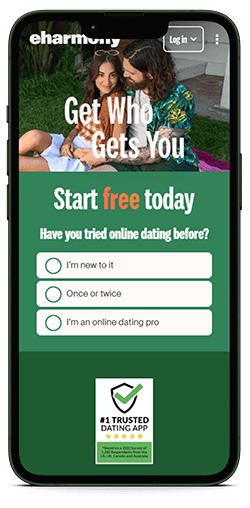
What’s eharmony Best For?
Online dating apps are much easier to choose when you know what each platform excels at. And eharmony, with its long-standing history and a solid reputation for its scientific approach to creating matches, used this set of strengths to benefit users looking for certain kinds of relationships—serious, committed ones.
- Long-Term Relationships: Known for helping users find serious, lasting connections.
- In-Depth Profiles: Provides comprehensive profiles to gain deep insights into matches.
- Compatibility-Based Matching: Uses a detailed questionnaire to find compatible matches.
- Guided Communication: Offers structured communication tools to help break the User Demographic: Attracts users who are typically more settled and looking for serious commitments.
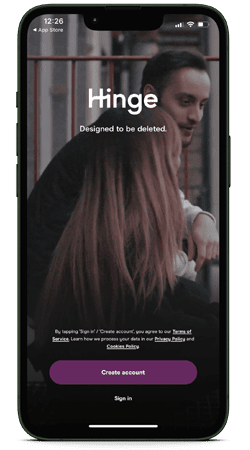
What’s Hinge Best For?
Overall, Hinge is best for those interested in finding serious relationships (after all, it is “designed to be deleted), and it’s great for those seeking something casual, too—whatever you’re looking for, Hinge can deliver!
- Designed to be Deleted: Hinge’s marketing slogan is “The dating app designed to be deleted.” This tagline underscores their commitment to helping users find a meaningful connection, encouraging them to uninstall the app once they find someone special.
- Quality Over Quantity: Unlike some apps that push endless swiping, Hinge prioritizes more substantial connections. This is done through profile prompts and the ability to express interest or comment on specific parts of a user’s dating profile.
- Engaging Profile Prompts: Hinge profiles feature responses to personal questions and creative prompts. These prompts highlight a user’s personality, preferences, and humor, offering a better understanding beyond profile pics.
- Date Feedback Feature: The “We Met” feature allows members to give feedback on their dates with matches—this helps Hinge refine its matching algorithm and highlights the platform’s emphasis on real-life dates and relationships.
- No Swiping: Instead of the conventional swipe mechanic, Hinge allows users to smoothly browse through profiles, encouraging them to invest more time in exploring and learning about potential matches.
- Limited Daily Likes: With the basic freemium version, users have a limited number of daily likes, promoting more thoughtful choices rather than mindlessly swiping through profiles.
Takeaways
Once again, choosing a dating app that’s best for what you’re looking for lies with your personal preferences–we’re just here to show you your options! In the case of eharmony vs. Hinge, both are solid choices if you’re searching for something serious in the romance department, although eharmony is more rigid in the way it approaches making matches on the platform.
Hinge is just as serious, but the app has a more relaxed atmosphere due to all the avenues for interaction, such as icebreakers, pre-written questions, and the ability to comment on specific parts of other members’ dating profiles. But we believe you can’t go wrong if you sign up for either one!
